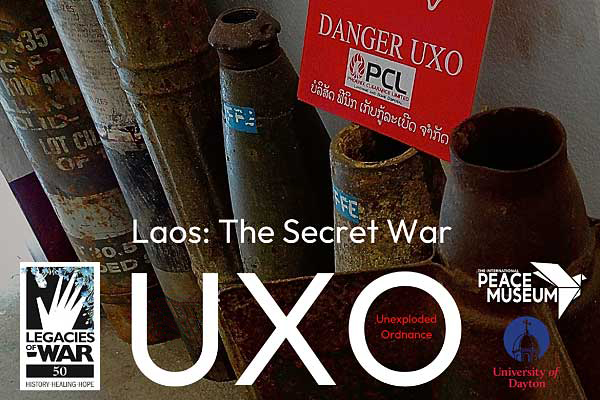News

Students help create International Peace Museum exhibit on legacy of cluster bombs
University of Dayton human rights studies students working with Legacies of War helped create an exhibit at Dayton's International Peace Museum showing the legacy of cluster bombs in Laos, which also could be a foreshadowing for Ukraine.
"People wondering about the long-term impacts of the war in Ukraine where both sides are using cluster bombs can see parallels in this exhibit," said Paul Morrow, visiting assistant professor in UD's Human Rights Center. "This exhibit shows the deadly effects of war in Southeast Asia from the 1960s to today, including unintended effects of tactical decisions during the conflict and the extent of damage to this region that endures half a century after the fighting ended.
"Besides shedding light on these hidden histories, this exhibit offers insights into the risks of using cluster bombs and landmines in present-day wars."
The special exhibit runs until Oct. 14 at the International Peace Museum at 10 N. Ludlow St. in Dayton and is free with paid admission to the museum.
"This is a landmark year for US communities with ties to Laos, Cambodia and Vietnam as it marks a half century since the last American troops left Vietnam, the last bombs were dropped on Laos and Cambodia, and the signing of the Paris Peace Accords," said Legacies of War Director Sera Koulabdara.
The exhibit features testimonies from Laotian, Hmong, and American observers and participants, photos from the front lines and eyewitness drawings. Among the testimonies is an excerpt of a letter by former U.S. Sen. Patrick Leahy and current U.S. Sen. Jeff Merkley that ran in The Washington Post expressing "why supplying Ukraine with cluster munitions would be a terrible mistake."
The following free public events also will be part of the exhibit:
- 7 p.m. Sept. 7: Koulabdara will lead a gallery walk of artifacts, art and photographs from the U.S. Secret War in Laos in the 1960s and 1970s and the aftermath of cluster munitions that continue to kill and maim civilians today.
- 2 p.m. Sept. 9: George Black, author of The Long Reckoning, will discuss his book, answer questions and hold a book signing. Black's book, according to Amazon, is the "story of how a small group of people — including two Vietnam veterans — forced the U.S. government to take responsibility for the ongoing horrors — agent orange and unexploded munitions — inflicted on the Vietnamese." Black will be joined by Morrow, Koulabdara, and Palina Louangketh, an educator and museum administrator who fled Laos as a child, to provide insight into how the events in Laos are connected to the war in Ukraine.
"The Peace Museum invites school groups, military veterans, government officials and all friends of peace to visit the exhibit so it hopefully spurs discussion on how to stop the use of these types of weapons or at least lessen their impacts in Ukraine, Yemen and other active conflict zones," International Peace Museum Director Kevin Kelly said. "As the saying goes, 'Those who forget history are doomed to repeat it.'
"And this certainly is history we do not want to repeat."
To interview Morrow, contact Shawn Robinson, associate director of news and communications, at srobinson1@udayton.edu. To interview Kelly or for more information about the museum, contact Kelly, at 937-397-4695 or kevin@peace.museum.
